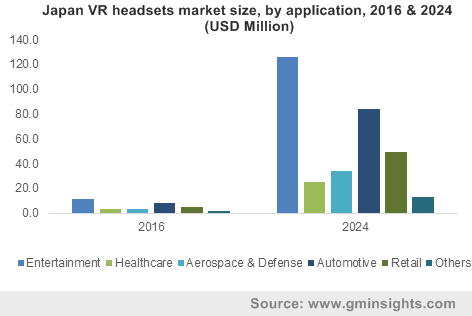Home > Media & Technology > Media and Entertainment > Audio Video > Mixed Reality Headsets Market
Mixed Reality Headsets Market Size
- Report ID: GMI2218
- Published Date: Nov 2017
- Report Format: PDF
Mixed Reality Headsets Market Size
Mixed Reality Headsets Market size was over USD 2 billion and shipments were over 10 million units in 2016, the industry is predicted to grow at over 35% CAGR from 2017 to 2024.

Growing penetration of VR and AR technologies across various applications such as automotive, gaming, healthcare, education, industrial; and retail is expected to drive the mixed reality headsets market growth over the forecast timespan. These devices are being rapidly adopted in retail, from apparel to home décor, to attract customers and increase brand loyalty. These devices allow retailers to immerse the customers in customized worlds.
The mixed reality headsets market has brought new dimensions to the education sector by simplifying the process of learning and teaching. For instance, in 2015, Microsoft HoloLens introduced HoloAnatomy. The AR tech displays real-time anatomical models and is used to teach the human anatomy in a better way. Furthermore, the education and technology ministries in several countries are taking initiatives to leverage the capabilities of these devices. For instance, the French Ministry of National Education revised the national curriculum to include the use of these devices in the learning process.
| Report Attribute | Details |
|---|---|
| Base Year: | 2016 |
| Mixed Reality Headsets Market Size in 2016: | 2 Billion (USD) |
| Forecast Period: | 2017 to 2024 |
| Forecast Period 2017 to 2024 CAGR: | 35% |
| 2024 Value Projection: | 35 Billion (USD) |
| Historical Data for: | 2013 to 2016 |
| No. of Pages: | 320 |
| Tables, Charts & Figures: | 351 |
| Segments covered: | Technology, Product, Application and Region |
| Growth Drivers: |
|
| Pitfalls & Challenges: |
|
Lack of quality content is expected to challenge the mixed reality headsets market. To attract customers and gain a strong foothold in the industry, companies need to ensure that enough good quality content is available on the internet. Moreover, rising health concerns due to the prolonged use is expected to challenge the industry in the long term. Users may also experience eye strain since they need to focus on a pixelated screen with these near-to-eye devices.
